|
|
|
Sort Order |
|
|
|
Items / Page
|
|
|
|
|
|
|
| Srl | Item |
| 1 |
ID:
089772
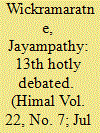

|
|
|
|
|
| Publication |
2009.
|
| Summary/Abstract |
The defeat of the LTTE as a military force has not made the ethnic question in Sri Lanka go away. If anything, the need for political solution has become ever more urgent. The euphoria over the military victory must allow the debate on power sharing and devolution to die. While these discussions take place, it is useful to go back to power-sharing arrangements already in place, and examine where they fall short.
|
|
|
|
|
|
|
|
|
|
|
|
|
|
|
|
| 2 |
ID:
138414
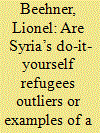

|
|
|
|
|
| Summary/Abstract |
Refugee camps are often treated as incubators of social unrest, violence, terrorism, and illicit trade. This provokes their overseers in the United Nations (UN) and other relief agencies to conduct frequent social engineering to enhance the camps’ legibility. Hence, we see orderly, perpendicular rows, standardized units from redistricting to the allocation of diapers, and so forth—all of the follies of high modernism that James Scott predicted in "Seeing Like a State," but writ small. Indeed, my qualitative research from the Za’atari refugee camp, located in Jordan along the Syrian border, indicates that refugees, especially middle-class ones like Syria’s, rebel against uniformity—or what Scott describes as “metis”—and seek to recreate their domiciles as best they can from the meager canvas tents and campers allotted to them. Put simply, they see their surroundings more as the disorderly “sidewalk ballet” of Jane Jacobs’ Greenwich Village than the high modernist yet sterile functionalism of Robert Moses. This holds important policy implications for the future of how we devise refugee camps, which increasingly resemble small cities; how we settle internally displaced persons (IDPs); and how we deal with the aftermath of mass population displacements. From direct cash transfers to the districting of refugees, some bureaucratic flexibility is required but so is an acknowledgement and embrace of refugees’ do-it-yourself ethos that is rooted in their resistance to authority and trauma from violence. Drawing from the literature in social anthropology and political science, this article presents new evidence from Za’atari that disputes the utility of a high modernist approach to the social engineering of large displaced populations.
|
|
|
|
|
|
|
|
|
|
|
|
|
|
|
|
| 3 |
ID:
070153
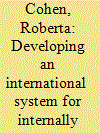

|
|
|
| 4 |
ID:
057598


|
|
|
| 5 |
ID:
130706
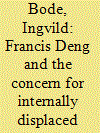

|
|
|
|
|
| Publication |
2014.
|
| Summary/Abstract |
Using the case of Francis Deng as representative of the Secretary-General for internally displaced persons as an example, this article considers how temporary civil servants may become intellectual leaders within the United Nations. During his 1992-2004 tenure, Deng managed to raise assistance and protection expectations for the internally displaced through framing their concerns in the concept of sovereignty as responsibility. He also contributed to legal change through formulating protection and assistance standards-the Guiding Principles on Internal Displacement. The article argues that a combination of three factors enabled him to exercise intellectual leadership. First, his insider-outsider position at the border between the UN Secretariat (the second UN) and the nongovernmental organizations, academic scholars, and independent experts who engage regularly with the UN (the third UN); second, his personal qualities; and third, his effective ways of framing at an opportune moment in time.
|
|
|
|
|
|
|
|
|
|
|
|
|
|
|
|
| 6 |
ID:
185139
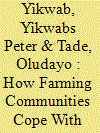

|
|
|
|
|
| Summary/Abstract |
A largely overlooked area in extant literature on farmer-herder conflict in Nigeria is coping strategies employed by internally displaced farming communities. Using exploratory design and qualitative data collection tools, we collected data from 23 purposively selected victims of farmer-herder conflict in Nasarawa State who were displaced and were either living in internally displaced persons camps or with friends/family. Findings showed that participants relied on their friends and family to cope with victimization experiences. Reported coping strategies included job switching, relocation to a safer place, formation of a vigilance group and trusting in God. The article recommends, among other things, empowering displaced populations with skills to cope with displacement challenges.
|
|
|
|
|
|
|
|
|
|
|
|
|
|
|
|
| 7 |
ID:
177035
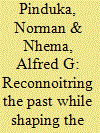

|
|
|
|
|
| Summary/Abstract |
The conflict that has embroiled the Democratic Republic of Congo (DRC) for decades has been one of the most vexing problems in the political history of Africa and the larger international community. The grave clashes predominantly in the eastern parts of the country have occasioned various challenges for the state and the world at large, chief among them a record of the internally displaced persons in the state. The forces that have led to internal displacement vary but this paper takes the view that it is a result of the identity crisis, a colonial sarcoma triggered by the arbitrary drawing of borders in the African continent, and in the context of the DRC, forcing 250 different ethnic groups to be embedded in a new state. The paper divulges that the identity crisis is one of the key attributing factors to the unending skirmishes in the DRC, which has led to the escalation of the forcibly displaced people. Without giving attention to such a convoluted historical problem through the establishment of a system based on equality at the national level, the DRC will continuously be infused with unending conflicts which will further precipitate numbers of the forcibly displaced in the country.
|
|
|
|
|
|
|
|
|
|
|
|
|
|
|
|
| 8 |
ID:
129032
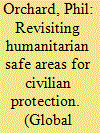

|
|
|
|
|
| Publication |
2014.
|
| Summary/Abstract |
Are safe areas an effective option to protect civilian populations from mass atrocities when they are targeted by their own state? Safe areas disappeared from the international lexicon following the failures in Bosnia and Rwanda. But they are now receiving a second look as a way of responding to mass atrocities without full-scale military intervention. This article argues that the earlier generation of safe areas failed not due to their size or cost, but rather because of problems inherent with their underlying logic. Safe areas were based either on logics of consent or the presence of a credible military force. Hybrid safe areas (such as in Bosnia) were based on neither of these, but instead relied on the legitimacy inherent in the UN Security Council. Crucially, in cases where civilians were being directly targeted by belligerents, both hybrid and consent-based safe areas collapsed. This has direct ramifications for present discussions around the Protection of Civilians agenda and the Responsibility to Protect doctrine.
|
|
|
|
|
|
|
|
|
|
|
|
|
|
|
|
| 9 |
ID:
117927
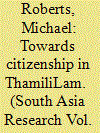

|
|
|
|
|
| Publication |
2013.
|
| Summary/Abstract |
In establishing the de facto state of Thamililam from 1990 onwards, the LTTE eliminated most of its Tamil rivals and mobilised the Tamil people for war in demanding ways. Despite its fascist character the Tiger state received the support of its subjects because it was understood to be a bulwark against Sinhala domination and the repository of sturdy Tamil nationalism, while the LTTE's propaganda cultivated a devotional aura around its mavirar (heroic dead).
This article highlights the strength of Tamil nationalism by interweaving this dimension within empirical details that outline Tamil political shifts and processes of migration from the 1970s to the 2000s. The centre of gravity in Tamil politics shifted first in the 1970s from a Colombo-Jaffna axis to a Jaffna-centric one and then from the Jaffna Peninsula to the Kilinochchi-Mullaitivu locality in 1995-96. The second spatial shift underpins the argument that the people under the LTTE were citizens of Thamililam. In technical terms they were dual citizens because they were also citizens of Sri Lanka. Where the latter claim was pressed-as it was, from different perspectives, by both the government of Sri Lanka and human rights advocates-one encountered a hegemonic imposition that denied the subjective feelings of those living within the de facto LTTE state. They were citizens of Thamililam. As such, they were enemies of Sri Lanka.
|
|
|
|
|
|
|
|
|
|
|
|
|
|
|
|
| 10 |
ID:
170312
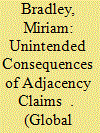

|
|
|
|
|
| Summary/Abstract |
This article examines the role of adjacency claims in the development of a norm for the international protection of internally displaced persons (IDP s). Consistent with existing scholarship on adjacency claims, the construction of analogies between refugee protection and IDP protection was instrumental in garnering broad international acceptance of the IDP protection norm. However, these same analogies had an impact beyond the abstract acceptance of the norm. They were used to justify the expansion of the mandate of the UN Refugee Agency (UNHCR) to encompass IDP s, and they shaped the way UNHCR understands and implements IDP protection. UNHCR replicated its policy approach from refugees to IDP s, generating a dysfunctional approach to IDP protection. Therefore, adjacency claims can have an effect beyond garnering support for new norms, and may result in suboptimal governance arrangements for implementing those norms.
|
|
|
|
|
|
|
|
|
|
|
|
|
|
|
|
|
|
|
|
|